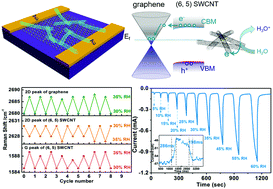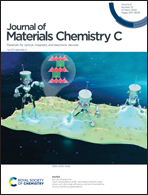Semiconducting single-walled carbon nanotube/graphene van der Waals junctions for highly sensitive all-carbon hybrid humidity sensors†
Abstract
van der Waals (vdW) heterojunctions composed of diverse atomic-thin nanomaterials have great potential as building blocks for innovative nanodevices due to the unique electron coupling effect. However, previous research studies have mainly focused on the light–matter interactions and charge transfer processes, and the interactions between gas/vapor and vdW heterojunctions still remain to be verified. Herein, we first demonstrate the charge transfer based on the interaction between water (H2O) molecules and the all-carbon vdW junctions, which are formed by stacking non-carboxylated (6, 5) single-walled carbon nanotubes (SWCNTs) on the surface of chemical vapor deposition synthesized graphene. Based on the interaction mechanism and charge transfer process, a proof-of-concept all-carbon vdW junction humidity sensor has been fabricated. The device exhibits good reproducibility and high sensitivity of 24% per 1% RH change in a wide relative humidity range of 5–80% with a short response/recovery time of 198/110 ms. Furthermore, the effect of H2O molecule absorption on the charge transfer dynamics at the SWCNT/graphene vdW junctions has been demonstrated via Raman spectra, giving a novel humidity sensing mechanism. Our finding provides a new strategy to fabricate high performance humidity sensors using vdW heterojunctions as sensing layers.



 Please wait while we load your content...
Please wait while we load your content...